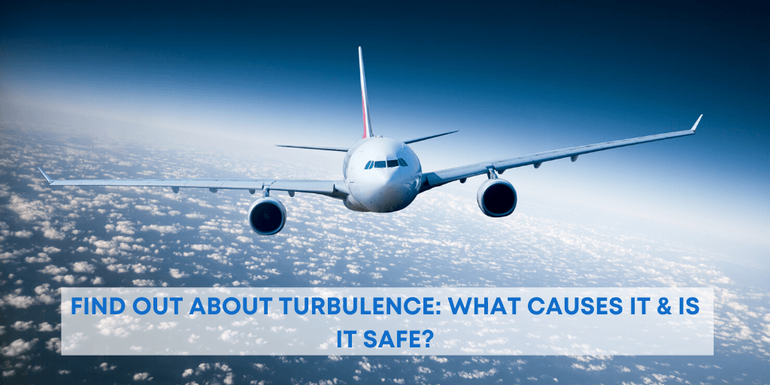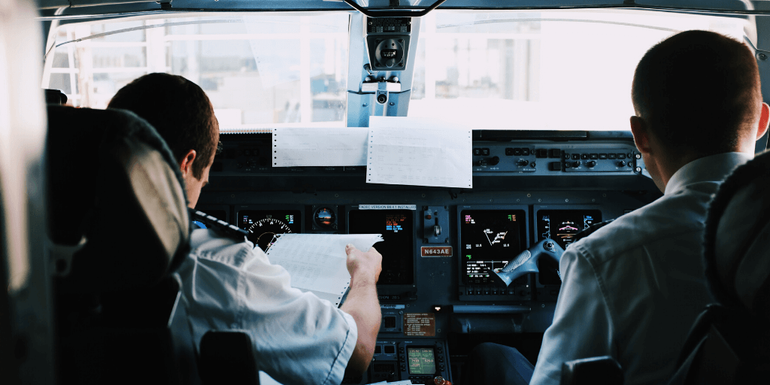Facts About Turbulence: What Causes It & Is It Safe?

One of the most common causes of anxiety on aeroplanes is turbulence. However, with these facts about turbulence, you’ll understand it is really nothing to worry about! We will break down exactly what turbulence is and what causes it to help allay any worries you may have.
What is turbulence?
Planes travel on wind flow and the majority of the time, it is smooth sailing. But there are times when the air can suddenly turn rough. This is turbulence. Think of it like ocean waves, so this, in turn, means the plane can sometimes rise, fall or sway to the side as it continues its journey through the sky when it’s experiencing turbulence.
What causes turbulence?
So what causes the wind to turn rough and cause turbulence? There are three common causes:
- Jet streams can trigger a sudden change in wind speed which can make the plane rock
- Thermal turbulence is when warm air rises from clouds and it meets cool air, causing turbulence
- Mechanical turbulence is caused by the landscape such as mountains or buildings that the plane is flying over, distorting the airflow.
During one of these times, the plane can feel like it’s shaking slightly, almost like a car on a bumpy road. One of the reasons it can feel so terrifying is because it feels like the plane is dropping, which it is ever so slightly, but because we are not used to it, it can feel like it’s a lot. But in reality, it’s only a slight movement.

Is turbulence dangerous?
We should remember that whilst this can feel scary, turbulence is not dangerous. Most of the modern aeroplanes are actually designed and very capable of withstanding turbulence. Patrick Smith, the host of AskThePilot.com reassures people that:
“A plane cannot be flipped upside-down, thrown into a tailspin, or otherwise flung from the sky by even the mightiest gust or air pocket.” He further said that whilst the “conditions might be annoying and uncomfortable, the plane is not going to crash”. So although it might feel scary at the time, remember it’s actually nothing to be worried about!
Are the pilots aware turbulence is going to happen?
Absolutely! The pilots will usually know that they are about to experience turbulence, all thanks to weather reports. So when they are about to hit the rough air, they alert air traffic control, as well as the other pilots that might also be using the same route. The crew on the ground can often also spot turbulent air by looking at weather conditions and patterns so they can alert the pilots. The pilots then let the passengers know to wear their seat belts and prepare themselves for the upcoming turbulence. What this means is that they will slow the plane down so that the plane can go through the rough air more gracefully. This technique is similar to how you would slow the car down when you see a bump in the road so that you don’t feel the impact as much.
However, there is one type of turbulence that pilots might not be able to predict! This is known as clear-air turbulence. This one appears to come out of nowhere. This gives the pilots the least amount of time to warn the passengers to wear their seat belts or return to their seat. This might be becoming more common due to climate change as carbon dioxide levels are rising and it’s having an impact on air levels. But if you follow the seat belt sign when displayed, you should be okay and remember, pilots are trained to deal with it so you are still in safe hands.
This is why it is very important that you follow instructions when the pilots say to wear your seat belt! As soon as the seat belt sign appears, you should make sure that you put it on without hesitation as this is a safety measure.
Hopefully understanding the facts around turbulence should help to reduce your concerns. The Federal Aviation Administration says that only 58 fliers get injured by year and considering roughly 8 million people fly every day, you can see how the chances of getting injured by turbulence are very low!

Turbulence coping techniques
If you are still anxious, we have prepared some tips that might help you cope with turbulence:
- Cynthia Drescher tells the Traveler that the way she deals with it is by bouncing! Seems slightly odd, right? But she explains that “I bounce in my seat without connection to the structure of the plane, or items fixed to it, and the more abrupt jolts of turbulence seem less severe”. Now, it seems quite logical that this would help – it’s almost like you’re going with the flow of the turbulence.
- Another tip is writing your name on a piece of paper! This one is given by Captain Ron Nielsen, who is a pilot and has worked in the airline industry for 40 years. Now he teaches classes on overcoming fear of flying. He suggests that “Put a pen in the opposite hand than what you normally use, and write your name. It first causes [the passenger] to focus extra-hard on what she’s doing, because she doesn’t normally write with her other hand. And the second thing is, it’s actually crossing over her motor function in her brain, using the other side of her brain from what she would normally do.” This seems pretty easy and sounds like a fun exercise to try too!
- What you can also do is fly early in the morning as that is known to be the best time to fly if you want to avoid turbulence. This is because the air is much smoother as it is cooler making your flight less likely to come across turbulence!
- There are also some flight routes in which you will experience much less turbulence. Statistics show that if you take flights away from the equator or the routes which involve flying over water or flat surfaces, you won’t experience as much turbulence.
We hope these facts and tips for coping with turbulence help. Whether you decide to bounce or write your name, just remember, it is really nothing to worry about and your plane is more than capable of handling it. We wish you safe travels! If you’ve discovered a technique that helps you deal with turbulence, we’d love to hear it in the comments below.
If you’re a first time traveller, why not check out our helpful guide on flying for the first time to put your nerves at ease!